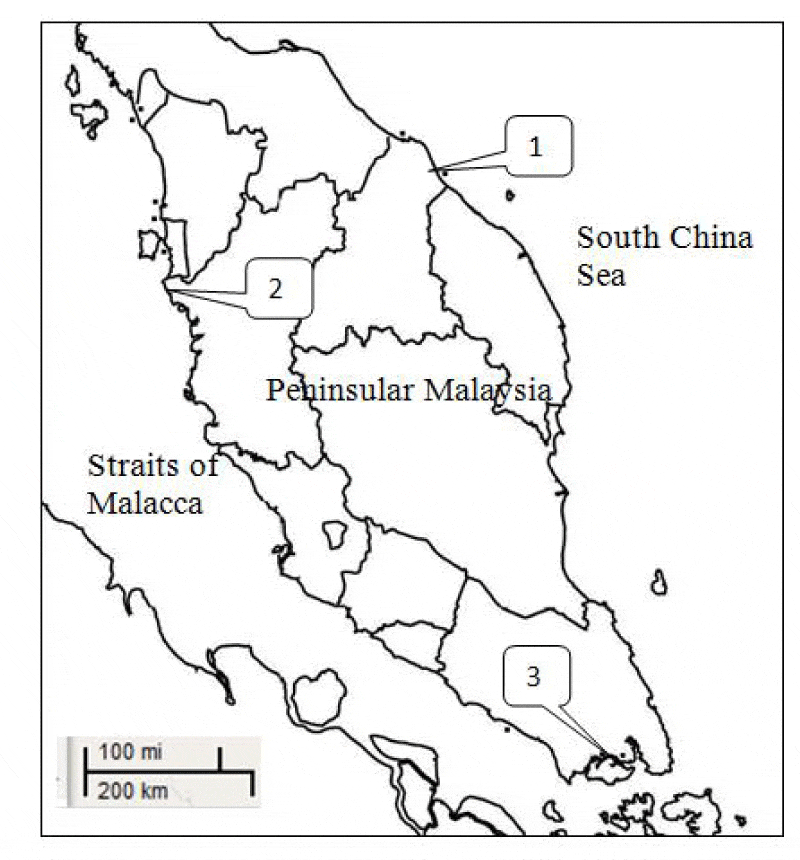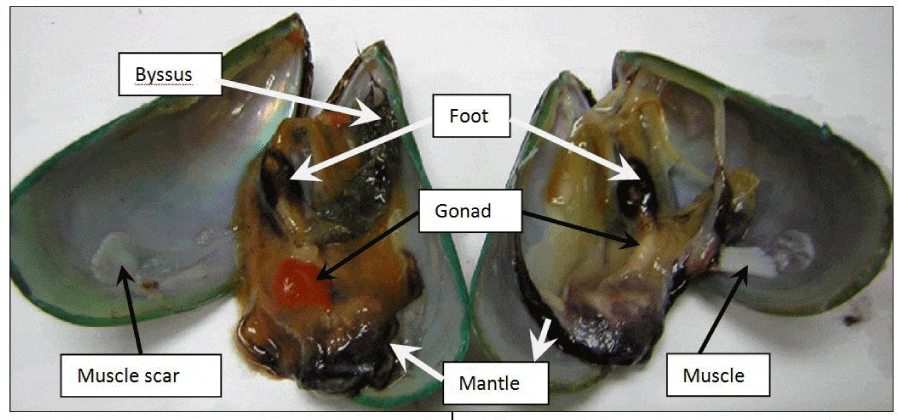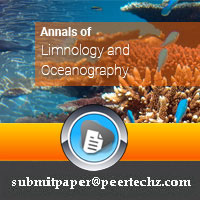Annals of Limnology and Oceanography
The Use of Foot of the Green-Lipped Mussel is Perna viridis as an Alternative Method to Reduce the Gender Effect on the Bioaccumulation of Cu and Zn in the Mussel
Chee Kong Yap1*, Yew Jeng Eugene Ng1, Franklin Berandah Edward Thomas2, Wan Hee Cheng3 and Ghim Hock Ong3
2Natural Resources and Environment Board, Petra Jaya, Locked Bag 2103, 93050 Kuching, Sarawak, Malaysia
3Inti International University, Persiaran Perdana BBN, 71800 Nilai, Negeri Sembilan, Malaysia
Cite this as
Yap CK, Eugene Ng YJ, Edward Thomas FB, Cheng WH, Ong GH (2016) The Use of Foot of the Green-Lipped Mussel is Perna viridis as an Alternative Method to Reduce the Gender Effect on the Bioaccumulation of Cu and Zn in the Mussel. Ann Limnol Oceanogr 1(1): 022-025. DOI: 10.17352/alo.000003In this study, the green-lipped mussels Perna viridis were collected from a high activity sampling at Senibong in the Straits of Johore and two relatively clean sites with fish aquacultural activity at Bagan Tiang (Perak) and Sg. Semerak (Kelantan). The mussels were dissected by gender into byssus, crystalline style, foot, gill, gonad, mantle and muscle. By gender, these pooled and dissected soft tissues and total soft tissues were determined for Cu and Zn. The variabilities of both metals between male and female were investigated by using coefficient of variation (CV). It is found that the low CV values among all the dissected soft tissues was foot, indicating a more accuracy in the biomonitoring of Cu and Zn using P. viridis’s foot. This suggests that foot of P. viridis can be used as an alternative method to reduce the gender effect on the bioaccumulation of Cu and Zn.
Introduction
In biomonitoring studies of heavy metals using marine mussels, the use of soft tissues without mentioning the ratios of male and female in a mussel population is always reported. For instance, Kljakovic´-Gašpic´ et al., Benali et al. [1,2] determined the trace metals in Mytilus galloprovincialis from eastern Adriatic and Algerian west coast, respectively, without differentiating the male and female individuals during analysis. If the number of female individuals analyzed is significantly higher than the male, the comparison of metal concentrations among the different populations would become low in accuracy. Furthermore, the ratios of male and female in the mussel populations collected are unknown during sampling until they are shucked from the shells and gender is usually revealed (although not accurately) from the color of the gonadal tissues. It has been widely reported in the literature [3-5], that gender is one of the intrinsic factors that could potentially cause variability of metal bioaccumulation in the body tissues of marine mussels including the green-lipped mussel Perna viridis [6].
In the study of metal concentrations of bivalves, it is very often that both genders are not separated and they are pooled and later analyzed for heavy metals. Regardless of the ratio of gender in the pooled samples, the results obtained will be used to compare different geographical mussel populations. Thus, these data used for comparison would become somewhat not convincing and needs further investigations. According to Yap et al. [7], in P. viridis, the background concentrations of metals in the females were generally higher than those in the males but the differences are not significant (P> 0.05).
Even if the mussels are separated and analyzed for metals by gender, the workload for the whole procedures are time consuming and complicated in terms of metal data obtained. In this study, coefficient of variation (CV) was used to determine the metal variability between male and female of P. viridis. It is hypothesized that selection of a particular tissue in P. viridis based on the lowest variability of metal concentrations between male and female can reduce the gender effect on the biomonitoring data. This would eventually increase the validity of biomonitoring data regardless of what genders of mussels are analyzed. Therefore, the objective of this study was to select a particular dissected soft tissue with the lowest CV and to propose its use as an alternative method to reduce the gender effect on the bioaccumulation of Cu and Zn.
Materials and Methods
Mussel samples were collected from Senibong, Bagan Tiang and Sungai Semerak (Figure 1). The reason why these sites were selected in this study because Senibong is an busy shipping site and potentially receiving industrial and domestic in the Straits of Johore while Bagan Tiang and Sg. Semerak are relatively unpolluted sites in Perak and Kelantan, respectively, with no observable human activities in the surroundings except for fish aquaculture (Table 1). All collected samples were kept in a cool box compartment until transportation to laboratory. In the laboratory, all the mussels from each site were separated into males and females based on the colour of the gonadal tissues (Figure 2). The gonadal contents after differentiation through visual inspection were further scrutinized by microscopic examination [6]. About 15 individual of one gender from one population were then dissected into different soft tissues namely muscle, crystalline style (CS), foot, mantle, gills, gonad and byssus. The size of mussels was selected from similar shell lengths between male and female individuals from each sampling site.
By gender, three replicates of each pooled dissected soft tissues and the total soft tissue of mussels were dried in 105°C until constant dry weights for at least 72 hours.
In detail, each individual of dried tissue of mussels was digested in concentrated HNO3 (AnalaR grade, BDH 69%). They were placed in a hot-block digester first at low temperature for 1 hour and then they were fully digested at high temperature (140°C) for at least 3 hours. The digested samples were then diluted to a certain volume with double distilled water. After filtration, the prepared samples were determined for Cu and Zn by using an air-acetylene flame atomic absorption spectrophotometer (AAS) Perkin-Elmer Model Analyst 800. The data were presented in µg/g of sample dry weight. To avoid possible contamination, all glassware and equipment used were acid-washed and procedural blanks were analyzed once for every five samples. Quality control samples made from standard solutions of Cu and Zn were analyzed in every five samples to check for the metal recoveries. The metal recoveries were being satisfactory (90-110%). The T-test between any two variables was conducted by using the STATISTICA software package.
Coefficient of variation
The coefficient of variation (CV) value is a well-known unitless index of ‘relative’ variation [8]. It is useful to relate the arithmetic means and the standard deviation together. The CV value is most useful in comparing the variability of several different samples, each with different arithmetic means. This is because a higher variability is usually expected when the standard deviation increases, and the CV value is a measure that accounts for the variability [9,10]. In each tissue, the CV value was calculated from the untransformed data as:-
Results and Discussion
Results of T-tests for shell lengths between male and female mussels are given in Tables 2 and 3. Apparently, the differences of shell lengths between male and female mussels in all the three sampling sites are not significant (P> 0.05). Therefore, the mussel body size may not contribute significantly to the variation of metal accumulation in the mussels.
The CV values of Zn and Cu between male and female in the different soft tissues of P. viridis collected from three sites are presented in Tables 2 and 3, respectively. For Zn, the lowest CV values among all the soft tissues investigated are consistently found in foot of P. viridis in Sg. Semerak (2.0%), Bagan Tiang (8.0%) and Senibong (4.4%) populations. For Cu, the lowest CV values are found in Sg. Semerak population (1.3%). In Bagan Tiang population, there are three soft tissues namely CS, foot and gill are recorded to have CV values below 5% while in Senibong population, foot and gills are found to be among the lowest CV found (6.6-6.7%).
Among foot, CS and gills, the mussel’s foot is a more practical tissue to reduce the gender variations of Cu and Zn because gills are more related to ambient dissolved metals in the seawater (hence, more variable since it is the first organ to connect with the metal entry) [6], while is more difficult to be dissected when compared to foot. For gonad and mantle, both tissues are highly influenced by spawning condition of the mussels [4]. Therefore, the variation of metal concentrations in these tissues is high and therefore the accuracy of metal data based on these tissues is low.
In term of practicality, foot is much more feasible and easily dissectable since it is located in the outside of the mussel body (Figure 2) when compared to CS and gills in which CS and gills are harder to dissect out of the mussel body. In addition, the function of foot is protrusion to outside the mussel shell in search of suitable substratum in time of unfavorable conditions occur. Thus, foot is important in making new byssal threads in a new substratum. The metal levels found in the foot are believed to have been fully assimilated. According to a review by Fraser et al. [11], exposure effects can be affected by the gender of mussels. Sokolowski et al. [12], reported that significant differences in trace metal concentrations between genders in Perna perna might have resulted from more intense formation of reproductive tissues and metal accumulation in sexual products of females during the prespawning and spawning periods. Therefore, the present finding is useful to reduce the errors of Cu and Zn accumulation due to gender effects.
Conclusion
In conclusion, the advantages of the present findings are a) the mussel foot is an easily dissectable soft part of mussels which warrant a simple application, b) the use of CV is relatively simple and easy to apply for the determination of metal variability between male and female of mussels, c) less time in biomonitoring of Cu and Zn, and finally d) higher precision in the use of foot as bimonitoring organ of Cu and Zn since low CV are found between male and female of P. viridis. Therefore, compared to many reported studies using total soft tissues, the use of mussel foot can reduce the gender effect on the bioaccumulation of Cu and Zn. Besides, a higher precision of Cu and Zn interpretation regardless of what gender of mussels are collected from the tropical coastal waters, can be obtained. However, further investigations under controlled laboratory conditions are still necessary to validate our claim.
The author wants to acknowledge the partial financial support provided through Fundamental Research Grant Scheme (FRGS) Phase 1/2016 [Vote no. 5524953] by Ministry of Higher Education Malaysia.
- Kljaković-Gaspić Z1, Herceg-Romanić S, Kozul D, Veza J (2010) Biomonitoring of organochlorine compounds and trace metals along the Eastern Adriatic coast (Croatia) using Mytilus galloprovincialis. Mar Poll Bull 60: 1879-1889. Link: https://goo.gl/Dx2xGf
- Benali I, Boutiba Z, Grandjean D, de Alencastro LF, Rouane-Hacene O, et al. (2016) Spatial distribution and biological effects of trace metals (Cu, Zn, Pb, Cd) and organic micropollutants (PCBs, PAHs) in mussels Mytilus galloprovincialis along the Algerian west coast. Mar Poll Bull Link: https://goo.gl/kFbEmQ
- Lobel PB, Wright DA (1982) Gonadal and nonganodal zinc concentration in mussels. Mar Poll Bull 13: 320-323.
- Lobel PB, Bajdik CD, Jackson SE, Longerich HP (1991) Improved protocol for collecting mussel watch specimens taking into account sex, size, condition, shell, shape and chronological age. Arch Environ Contam Toxicol 21: 409-414. Link: https://goo.gl/vdDBmD
- Gay D, Maher W (2003) Natural variation of copper, zinc, cadmium and selenium concentrations in Bembicium nanum and their potential use as a biomonitor of trace metals, Wat. Res 37: 2173-2185. Link: https://goo.gl/8evQTL
- Yap CK, Ismail A, Tan SG, Rahim Ismail A (2006a) Is gender a factor contributing to the natural variations in the accumulation of heavy metals (Cd, Cu, Pb and Zn) by the green-lipped mussel Perna viridis? Indian J Mar Sci 35: 29-35. Link: https://goo.gl/fn2EYC
- Yap CK, Ismail A, Rahim Ismail A, Tan SG (2006b) Biomonitoring of ambient concentrations of Cd, Cu, Pb and Zn in the coastal wetland water by using gills of the green-lipped mussel Perna viridis. Wetland Sci 4: 247-252. Link: https://goo.gl/o0ichk
- Lobel PB, Belkhode SP, Jackson SE, Longerich HP (1989) A universal method for quantifying and comparing the residual variability of element concentrations in biological tissues using 25 elements in the mussel Mytilus edulis as a model. Mar Biol 102: 513–523. Link: https://goo.gl/UUAbI9
- Lobel PB (1986) Role of the kidney in determining the whole soft tissue zinc concentration of individual mussels. Mytilus edulis. Mar Biol 92: 355-359. Link: https://goo.gl/87st86
- Rosner B (1990) Fundamentals of Biostatistics (3th ed.). DWS-Kent Publishing Company, Boston. 23.
- Fraser M, Fortier M, Roumier PH, Parent L, Brousseau P, et al. (2016) Sex determination in blue mussels: Which method to choose? Mar Environ Res 120: 78-85. Link: https://goo.gl/3Daqgs
- Sokolowski A1, Bawazir AS, Wolowicz M (2004) Trace metals in the brown mussel Perna from the coastal waters off Yemen (Gulf of Aden): How concentrations are affected by weight, sex, and easonal cycle. Arch Environ Contam Toxicol 46: 67-80. Link: https://goo.gl/JaPW6Z
- Yap CK, Rahim Ismail A, Ismail A, Tan SG (2003) Studies on heavy metal accumulations in green-lipped mussel Perna viridis by using multiple linear stepwise regression analysis. Pertanika J Sci Technol 11: 43-55. Link: https://goo.gl/qdz9ni
Article Alerts
Subscribe to our articles alerts and stay tuned.
 This work is licensed under a Creative Commons Attribution 4.0 International License.
This work is licensed under a Creative Commons Attribution 4.0 International License.



 Save to Mendeley
Save to Mendeley
